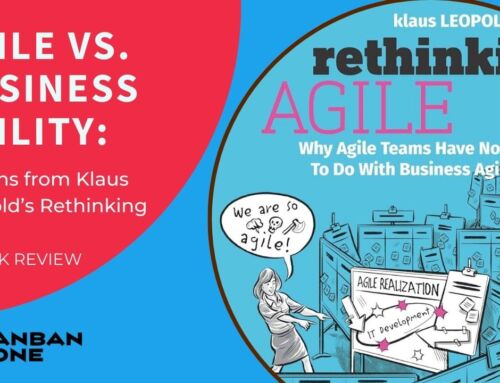
Times of uncertainty have perturbed our status quo. Many of us are dealing with different lifestyles as opposed to our previous, almost mundane routines. On the professional front too, work-from-home opened doors and people’s perspectives. Workspaces are being redesigned, remote employees are being hired, newer technologies are being explored and employees and employers are learning to experiment with different skills and capabilities.
Embracing Continuous Improvement for a Smooth Agile Process
The term agility according to the dictionary means the ability to move quickly and easily. Just like the name, the Agile process makes the work process better with time. The reason being it involves continuous learning and improvement and continuous experimentation at its heart. Agile divides different processes of developing a product into smaller parts. Designated teams are assigned to work on every small part of the product, which makes building a product much swifter and effective due to repetitions.
Unfortunately, most businesses start shifting to Agile without establishing a clear understanding of the concept. Hence, it is imperative that before one set on the path, one must have a clear knowledge of one’s desired outcomes. Begin with expectations. Understand how a set of rules works and then move on to define a clear-cut intended outcome. Then, define your ability to apply Agile principles and adapt them to the needs of your organization.
Ken Schwaber, in his book Software in 30 Days: How Agile Managers Beat the Odds, Delight Their Customers, And Leave Competitors In the Dust, says, “A manager’s most important work is helping the people doing the work. Give them a goal and let them work. Remove any impediments that get in their way. Do anything that may make them more effective or productive. Then the organization can capitalize on the fruits of their work.”
Agile Workflow is like a missing part of a puzzle. When it is fit in the right place, it not only completes the picture but lifts the entire organization on its able shoulders. Apurva Muthe, Founder, Sproute Media, “I think agile work structure is something that builds up any successful company. Agile Work Structure is like the pillar that’s based on the core values and talents of the people in the company. As an Entrepreneur, I learnt this the hard way after failing in almost 6 businesses that I tried to do alone, but then agile work was something that was the missing ingredient and now finally while running a successful ad agency, I brought in this missing ingredient and now we a team of multi-talented individuals who are helping us to grow and scale our business to new heights. Agile Work is the necessity of the current era, you could be running a start-up or a corporate, but Agile work has to be the main ingredient of your organization at every stage”.
Your Blueprint to Make Adoption of Agile Workflow a Cake Walk
Step 1: Establish a thorough understanding of Agile.
The main idea of Agile is to split the project into small parts that are called iterations, each of which is focused on releasing a small valuable piece of the product as quickly as possible and learning from the feedback. This feedback becomes a pathway for future improvements.
Asif Huddani, an industry expert uses a beautiful analogy to explain Agile, “The Agile workflow provides a significant advantage over the waterfall model. Agile provides multiple frameworks which can be choose based on team knowledge, customer likelihood and depends upon a final goal to achieve. Let us understand with an example of hotel booking. If we use an Agile approach in hotel booking applications, we can split the process of the entire software into process-wise modules. e.g., customer management, room management and availability booking management, payment collection, etc. Agile provides a team with flexibility and focuses only 1 module at a time where the team builds that module and releases it for actual use. So, when a new customer comes their data can be entered and managed in the system, the rest of the process remains outside the system.”
“With the launch of room management and availability, now we can do auto allocation of customers and rooms. Later, we can move on to online booking management and then to the last step payment processing and collection. If at any point in time, the customers want to make changes in the requirement they can do it because those modules are not built,” he adds.
Step 2: Make a checklist of hurdles and challenges.
The best thing about Agile is that it can bring huge business value. But it is a herculean task to apply changes across the entire corporate chain, right from processes to operation and weaving the elements of culture and organizational behaviour. Agile demands a shift in behavior. Corporate chains could be left disrupted if Agile is implemented without a deep dive into understanding what exactly goes into it.
The successful implementation of an Agile workflow is embedded in the principles of teamwork, transparent policies and flexibility. These elements could pose as a hurdle for relatively large-scale organizations as compared to small and medium scale businesses. The latter have more ability to take disruptions in their stride.
Instead of manually managing your tasks and processes, you can also adapt to a digital tool like Kanban Zone, which lets you implement Agile Transformation at the enterprise level. This virtual Kanban board is among the different Agile methodologies that you can use to help you simplify your processes, which makes it more efficient as compared to other tools.
Step 3: Customize your Agile workflow.
Agile strategy can be customized as and when needed. If you’re looking to restructure processes to boost your business’s overall productivity, there are a few things you need to take note of:
- Know where you are at the moment (your current state of business).
- Gradually inch toward achieving your goal.
- Adapt and evolve from your learning and experience.
- Iterate.
Decide which activities are better suited for Agile, that is, where you can break a complex problem into parts. Agile fits best for ventures with complex problems and where solutions may not be apparent. Agile works well when changes are still possible during the process and there is great collaboration in the team (e.g., in areas like product development, marketing campaigns, sales activities and recruiting).
Step 4: Create an initiation plan.
When it comes to Agile planning, the best way to go is to take one step at a time. Recognize the areas of the company you want to transform. Mark areas of opportunity where Agile can be smoothly implemented. Once you have discovered those areas, you need to zero down upon the best approach considering the critical elements of your business. Then move on to deciding which Agile practices you’ll be taking into account: Processes, People or Technology etc.
Step 5: Build a Shared Vision.
Employees have an emotional commitment and stronger affinity to their work when they work in close collaboration towards a common goal. This is how Agile works too.
Having a carefully drafted and shared vision while implementing the process of Agile is what sails your company through the seas of change. A shared vision will serve as a barometer that can help you measure the progress during the process and make critical decisions.
Step 5: Adopt and Adapt.
Agile helps your team to prioritize tasks and provides an effective and efficient solution to problems. Interestingly, Innovations and Agile work hand in glove. Agile provides a platform to conduct safe experimentation that doesn’t put the project at risk but becomes a learning mechanism to experiment. Safe to fail trials helps one learn from one’s shortcomings and respond swiftly. While implementing this methodology, you can have your stakeholders on board and keep them abreast with the progress of the project.
Learn. Experiment. Innovate. Adopt. Adapt… That’s the Agile way. Learn from micro failure so that you are not crushed under the weight of macro-failures.
Step 6: Encourage and Empower.
Corporate culture is traditionally designed to be authoritative and hierarchical. Agile is not designed to follow authority and centres around continuous improvement, adaptability, freedom to experiment and learn from mistakes and continuous learning. Agile is like an inspiring leader and not a commanding boss who empowers every employee involved and pushes them to perform to the best of their abilities. Agile mentors, the team to work in tandem and keep learning, evolving and adapting at every single step thereby providing a harmonious organizational culture.
Step 7: Provide Psychological Safety.
Psychological Safety is an important trait of high-performing teams. PS defines how often the team engages in key learning behaviours. This includes sharing information, experimenting, cross-checking to eliminate doubt, suggest improvements to plug loopholes and asking questions. Amy Edmonson, author of the popular book The Fearless Organization puts it across beautifully, “Psychological Safety takes off the brakes that keep people from achieving what’s possible. But it’s not the fuel that powers the car.”
To sum it up… It is not an easy feat to implement Agile, especially in a well-established business enterprise. It requires a thorough preparation and planning before the execution. But when applied, the Agile workflow will help streamline your business operations and empower your human resources.
This was a guest blog. Please review our guest blog disclaimer.
Learn to Work Smarter, Not Harder!
Get our top articles weekly.
Table Of Contents
Discover many more posts…







